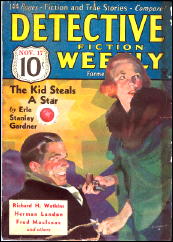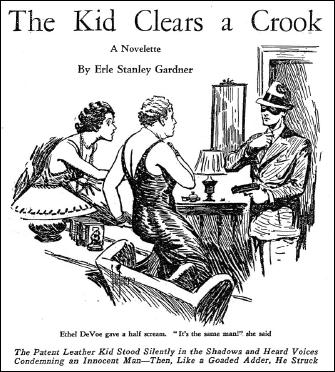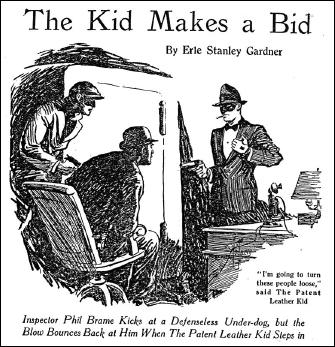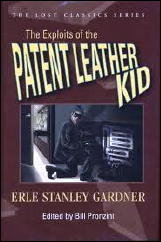Thu 8 Dec 2011
Characters from DFW #9: THE PATENT LEATHER KID — by Monte Herridge.
Posted by Steve under Bibliographies, Lists & Checklists , Characters , Columns , Pulp Fiction[14] Comments
DETECTIVE FICTION WEEKLY
by MONTE HERRIDGE
#9. THE PATENT LEATHER KID, by Erle Stanley Gardner.
The Patent Leather Kid is another leading character created by Erle Stanley Gardner. Someone with that identity first appeared in “The Gems of Tai Lee,†a story in the March 25, 1930, issue of Clues, but when the Kid showed up again, in the May 28, 1932, issue of Detective Fiction Weekly, he was a new character, the star of the first of a series of adventures that ended two years later.

He had a dual identity in the DFW stories – normally rich Dan Seller most of the time, and The Patent Leather Kid when he is ready for one of his somewhat illegal adventures. The patent leather in the name comes from his wearing not only patent leather shoes but also a patent leather face mask to hide his identity.
The Patent Leather Kid “was always on the lookout for adventure, and anything sufficiently out of the usual called him with an irresistible attraction.†(The Kid Stacks a Deck)
There is a cast of regular characters for each of his identities. The stories usually start out with a scene of Dan Seller and his fellows at their club, discussing the latest criminal event or activity. The other club members are firstly Police Inspector Phil Brame, then Renfroe the bank president, and Bill Pope the explorer.
Brame usually brings up a criminal event, which causes disagreement among the others and ends with Seller or Bill Pope often betting on the outcome with him. Brame always loses these bets, but that does not keep him from trying again. Renfroe agrees with the Inspector much of the time, but also tries to avoid antagonizing Seller because he is a large depositor in his bank. It is not revealed how well off Dan Seller is, or where his money comes from.
In his identity of the Patent Leather Kid, he has another group of people. There is Bill Brakey, The Kid’s bodyguard and assistant. He is also called “A walking encyclopedia of the underworld,†and this comes in handy for The Kid’s adventures. Brakey usually knows the answer to any question about the underworld, or can get the information easily.
Another person in this group is Gertie, the telephone operator in his apartment house. She keeps track of his messages and also keeps an eye on The Kid’s special elevator which was constructed for his own use. She also knows his identity as Dan Seller. Interestingly, Gertie is also the name of Perry Mason’s telephone operator.
There are only three people in the apartment house hotel who know Dan Seller’s dual identity: Bill Brakey, Gertie, and the desk clerk who is never named.
The Patent Leather Kid lived in an apartment house hotel penthouse, with his special security extras such as a steel door and alarms systems. According to one story (The Kid Clips a Coupon), with these security arrangements: “no one could get through the roof without a warning coming over the telephone, without an automatic alarm shrilling a strident warning should the only elevator which communicated with the penthouse start on its way without The Kid’s having first unlocked an electrical contact.â€

The stories involve various kinds of adventures. In “The Kid Clears a Crook,†a reformed criminal trying to go straight is framed and taken advantage of by underworld crooks, and the police don’t care. The Kid sets out to clear the ex-crook and set the blame where it belongs, thereby infuriating both the underworld and the police.
Neither group likes interference from The Kid in their affairs, and try repeatedly to eliminate him. The police even (according to Inspector Brame) give the underworld the green light to eliminate The Kid, but this never happens. Brame even states that if they catch the Kid, they will frame criminal charges on him in order to keep him in jail for a long time.
The Kid enjoys this, in his words: “In this game of matching wits with the law, The Patent Leather Kid found his most fascinating recreation. He gambled with life and liberty, and enjoyed the game.†(The Kid Stacks a Deck) So the acquisition of money or property gained illegally is definitely not the goal of The Kid.
The first story to appear in DFW, “The Kid Stacks a Deck,†is a bit different than the others in the series. Bill Brakey does not appear in this story, and Gertie is present but not named. Inspector Brame is given the title of Commissioner, which he loses in later stories. Possibly the author thought the stories more effective with a lower ranking policeman.
In the story, The Kid finds out that a criminal gang is out to kill him, so he sets a trap for them. He breaks into a jewelry store, steals a few items and mails them to Brame and his family. The gang is waiting outside to shoot and rob him as he leaves. However, The Kid alerts the police who attack and wipe out the gang as The Kid escapes.

The story presents the image of The Kid as a master burglar without peer in the underworld and with a high reputation for those talents. However, he seems to have gained nothing from his burglary of the jewelry store. In fact, a point is made throughout the series that “The police had never been able to brand him specifically as a crook. He was a big shot, and his ways were the ways of the underworld, but they had never as yet pinned any definite crime upon him.†(The Kid Wins a Wager)
Inspector Brame’s chief complaint about The Patent Leather Kid was that his activities damaged the dignity of the police and made them look bad and caused people (and The Kid) to laugh at them. That was a terrible offense to Brame. He seems to have cared more about the dignity of the police department than anything else.
In “The Kid Throws a Stone,†The Kid is involved in a case where someone is impersonating him. The impersonator has already pulled one robbery before the real Patent Leather Kid starts his complex counter-offensive.
In another case of impersonation told in “The Kid Wins a Wagerâ€, a criminal burglarizes a jewelry story and leave a note supposedly signed by The Patent Leather Kid. Fortunately, The Kid catches him in the act and clears that up.
One of The Kid’s favorite tactics was to get criminals, who are after him, into confrontations with the police, where they invariably wind up shot. Rarely does The Kid have to use a gun on the criminals themselves, but this does occur in the story “The Kid Cooks a Goose,†where he and Bill Brakey are trying to protect a woman from a gang of killers. They shoot it out with the three killers and wipe out the gang.
This is a fun series, and Gardner is obviously enjoying himself writing these improbable situations. On a “Writer’s Almanac” episode on NPR (National Public Radio), Garrison Keillor quotes Gardner as saying about his pulp work: “I write to make money, and I write to give the reader sheer fun.”
The Patent Leather Kid series by Erle Stanley Gardner:
The Gems of Tai Lee Clues, 25 March 25 1930 [This story features a different “Patent Leather Kid,†as it turns out. See comment #12.]
The Patent Leather Kid discussed above appeared as a character only in Detective Fiction Weekly:

The Kid Stacks a Deck May 28, 1932
The Kid Passes the Sugar July 16, 1932
The Kid Wins a Wager September 10, 1932
The Kid Throws a Stone October 22, 1932
The Kid Makes a Bid February 18, 1933
The Kid Muscles In April 15, 1933
The Kid Takes a Cut May 20, 1933
The Kid Beats the Gun August 5, 1933
The Kid Covers a Kill November 4, 1933
The Kid Clears a Crook February 3, 1934
The Kid Clips a Coupon April 21, 1934
The Kid Cooks a Goose July 14, 1934
The Kid Steals a Star November 17, 1934
NOTE: The 13 stories that appeared in Detective Fiction Weekly have been collected in The Exploits of the Patent Leather Kid, edited by Bill Pronzini (Crippen & Landru, 2011).
Previously in this series:
1. SHAMUS MAGUIRE, by Stanley Day.
2. HAPPY McGONIGLE, by Paul Allenby.
3. ARTY BEELE, by Ruth & Alexander Wilson.
4. COLIN HAIG, by H. Bedford-Jones.
5. SECRET AGENT GEORGE DEVRITE, by Tom Curry.
6. BATTLE McKIM, by Edward Parrish Ware.
7. TUG NORTON by Edward Parrish Ware.
8. CANDID JONES by Richard Sale.
December 8th, 2011 at 7:36 pm
Nice study as always, Monte. I’ve never read any of these stories, but the Kid sounds a bit close to some of McCulley’s gentlemen crooks. It might be fun reading them. I’ll have to look up Bill Pronzini’s book.
December 8th, 2011 at 7:44 pm
This has to be the first time that the stories in one of Monte’s columns are going to be found easily, and all in one place. If you were to try to find all thirteen of the magazines these stories were in, it would take you nearly forever, or close to it. It would also be a lot more expensive — but might be worth it, considering all of the other stories you’d get to read.
December 8th, 2011 at 7:49 pm
Gardner did love the gentleman crook type of story, the most famous being Lester Leith in DFW and Ed Jenkins, the Phantom Crook, in BLACK MASK. There were dozens of the Lester Leith stories, so Monte will have his work cut out for him. Maybe he can read a dozen or so and then list the rest…
December 8th, 2011 at 8:28 pm
In the mid-twenties this was the title of a boxing film. Quite successful.
December 9th, 2011 at 2:42 pm
I don’t think Mike Grost will mind my excerpting a long section of text from his website. It’s taken from
http://mikegrost.com/gardner.htm#Gardner
and it helps explain the great popularity that his characters enjoyed, such as the Patent Leather Kid:
“Erle Stanley Gardner’s main story series have a consistent point of view. His pulp series, such as Ed Jenkins, Lester Leith, or the Patent Leather Kid, tend to be about sympathetic crooks. These crooks are powerful figures who stand up for the little guy. They defy the police, the first ‘seriously,’ the last two humorously tweaking their noses. His main novel series, the Perry Mason books, are not about a crook, but their principal character also defies the police and authority. Mason helps people in trouble. Leith and the Kid were both gentlemen of (ill-gotten) wealth, and were powerful sources of support for the little guy in the Depression. Mason is also a figure of great success and substance. All represent very powerful men who intervene between the authorities and people in trouble. Although the Leith tales recall Arsene Lupin, and the Jenkins other rogue stories, Gardner goes beyond these traditions. Most of the rogues were out for themselves. All of Gardner’s characters make a good living out of what they do, but they all seem to help ordinary people along the way. Their anti-authoritarian actions seem to have a democratic or rebellious side to them, not just to be a perverse gesture flung in the face of authority like the rogues.”
— Mike Grost
December 9th, 2011 at 3:11 pm
Replying to Barry in Comment #4, the name’s the same, but checking with a commenter on IDBD, he says this about the movie:
“THE PATENT LEATHER KID ranks among the great silent films. Based on the best-selling novel by Rupert Hughes, this long and ambitious film is almost two films in one.
Richard Barthelmess, who won an Oscar nomination for best actor, stars as the boxing champion known as the Patent Leather Kid because of his hair (think of Rudolph Valentino). He’s a cocky fighter who, between rounds in the ring, has his fair [hair] combed while the opponent gasps for air and is washed down. Molly O’Day plays Curley, a kooch dancer who gets involved with the Kid and brings him down. She’s a bad-luck gal and diverts the Kid’s attentions from his business: boxing.”
There doesn’t seem to be any other resemblance between the film, which came first, and Gardner’s character. Even the reasons for ‘Patent Leather’ in their names are different.
For what it’s worth, before I read one of the stories in the series, I thought it had something to do with his shoes.
December 9th, 2011 at 3:45 pm
Steve–
Just thought Gardner must have been aware of the Barthelmess film, liked the title-concept and applied it in a different way.
December 9th, 2011 at 4:39 pm
Barry —
The film was very popular. I’m sure Gardner must have been aware of it. Even though I didn’t some up with any other similarities between the characters, your hypothesis is a good one.
That he took the name and tinkered around with it a little, I could believe it.
December 9th, 2011 at 3:57 pm
The basic concept behind Gardner’s rogues reminds one of C.G. Jung ‘s figure of the ‘ Heldenkind’.
The Doc
December 9th, 2011 at 4:54 pm
Doc
Heldenkind translates to “Hero Kid,” am I correct?
December 9th, 2011 at 7:14 pm
YUP, Steve, I don’t know the English termini technici in analytical psychology, and do not adhere to it, but understand the fascination emanating from it, in being the sole serious school, that embraces something metaphysical.
The Doc
December 12th, 2011 at 1:13 pm
Monte,
You will probably want to make a small revision to your article. “The Gems of Tai Lee†story that appears in Clues, March 25, 1930 is not a Patent Leather Kid story. The character goes by the name Patent Leather Kid but he is not the same series character profiled in your essay, hence the reason it was left out of the collection The Exploits of the Patent Leather Kid, edited by Bill Pronzini. Pronzini for some reason does not mention this reason in his introduction.
December 12th, 2011 at 1:42 pm
Thanks, Rob. I’ll make a note of this in the article itself. I’d meant to inquire further about this, but time — as usual — got away from me.
LATER THE SAME DAY. Monte has pointed out that the first paragraph also needs to be rewritten, which we’ve done.
Bill Pronzini has confirmed that the first Patent Leather Kid is a separate character, saying ” I made no mention of the fact in my introduction because it didn’t seem particularly relevant or notable at the time. Maybe I should have, but it’s a minor point in any case; the important thing is that all the true Kid stories from DFW appear in the collection.”
November 8th, 2023 at 8:28 pm
[…] For even more about The Patent Leather Kid, see Monte Herridge’s Mystery*File article here: https://mysteryfile.com/blog/?p=13823. […]